Face of the NFL? Saquon Barkley Has a Plan

How did Saquon Barkley transform into the perfect prospect? SI goes Under the Cover with his coaches, teammates and family to learn more about the draft’s most buzzed about player. You can now watch anytime, anywhere on SI TV. Learn more at SI.TV.
Saquon Barkley doesn’t want this to be a feel-good story—that’s the first thing he says after sitting down for breakfast at a small Spanish coffee shop in the South Bronx neighborhood where he was born. It’s just after eight on a frigid March morning. The NFL draft is six weeks away. Yesterday the Pennsylvania House of Representatives officially celebrated Saquon Barkley Day, feting him in the state capital of Harrisburg, 95 miles from Penn State, where he smashed rushing records and racked up defender-hurdling highlights; next week there will be a parade in his honor in Coplay, the town where his family moved when he was five. Barkley will ride through the streets propped on the backseat of a convertible as a marching band plays and nearly all 3,200 residents cheer. Then he will give a speech, asking his fans to stay with him when he makes mistakes. He is human after all, he will say. Because sometimes it is hard to tell.
A waitress approaches. Barkley orders pancakes, three eggs, turkey sausage and home fries—green peppers, no onions—then asks his mom, Tonya, if he takes milk or half-and-half in his sweetened coffee. He sticks a straw in the cup and sips. The drink is hot and creamy, and Barkley coos with delight.
What he doesn’t want is for this story to elicit sympathy—awww, look at all the adversity Saquon Barkley fought through to get here. Dad had a drug problem and was in and out of jail. Mom uprooted the clan to the rural Lehigh Valley, searching for a better life for Saquon and his four siblings. Then Dad got sober and was brutally honest with his children about his struggles, ensuring they wouldn’t make the same mistakes. But that’s the past. “I want this to be about where I’m going next,” Barkley says.
Breakfast is finished and Barkley walks outside, decked head-to-toe in Nike gear—track pants, hoodie, jacket and backward snapback, all black. He asks if the camera crew can get a shot of his shoes, the rare off-white Air Jordan 1’s, to help his standing within the company. When he poses for a photo outside his childhood apartment, he adjusts his jacket so the swoosh is visible. He prides himself on being a good brand partner.
Even before he has taken an NFL handoff, the 6-foot, 233-pound Barkley sees an opening in football’s marketing landscape and—rare for a rookie—he has concrete plans on how to accelerate through it. It’s why he signed with the boutique, full-service agency Roc Nation, which has built a 15-man team around him. It’s why today in the Bronx, a half-dozen members of that team are shadowing him, making sure that he stays on message and on brand. Not that they have to worry much. Barkley’s team believes he has the potential to be the Face of the League, position bias be damned.
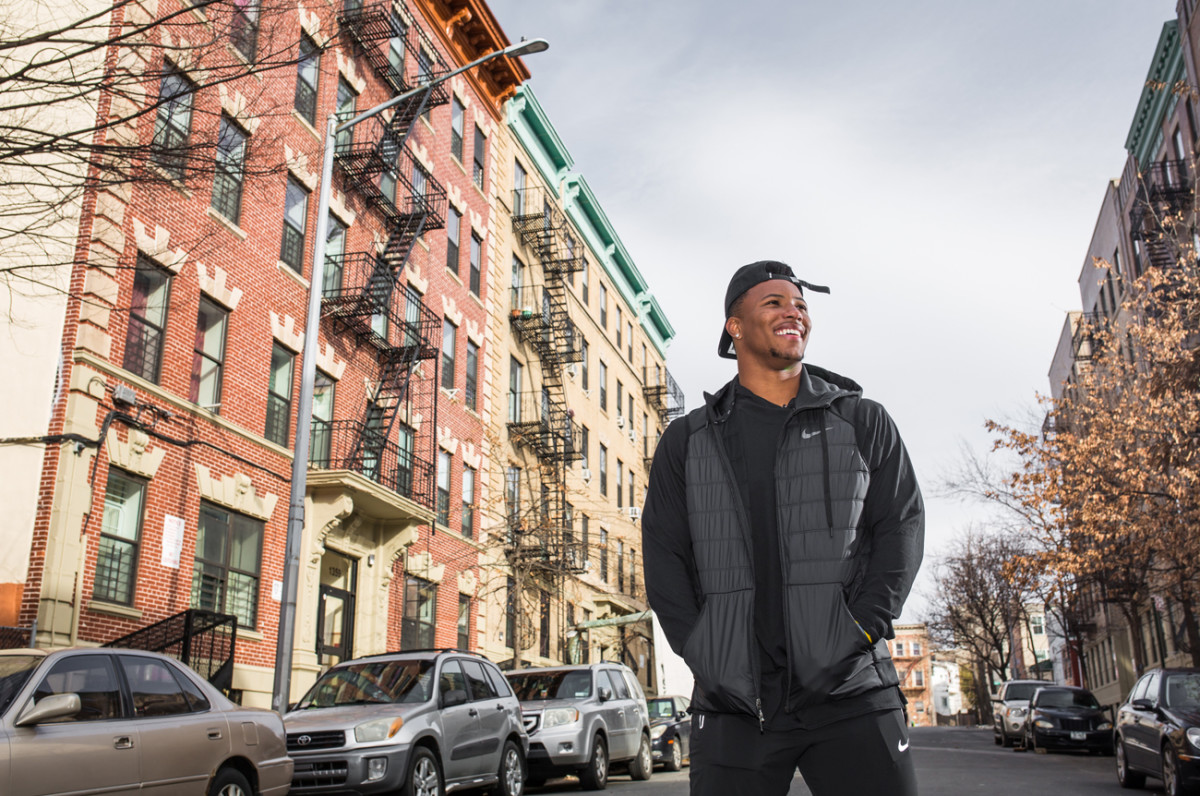
It may be a quixotic goal, but it is not hard to see why the group feels that way. Barkley is jocular, thoughtful, self-aware and rigorous about making eye contact. He apologizes profusely for being late (despite it not being his fault) and will ask a passenger sitting behind him in an Uber if he has enough room, then unnecessarily scoot his seat forward. A broadcast journalism major, he’s at ease in front of a camera; it doesn’t take much straining of the imagination to envision him bantering with Jimmy Kimmel or hosting Saturday Night Live. But most important, he is willing. Willing to sit for interviews—he says he actually enjoys them—and willing to participate in (and at times orchestrate) a three-hour photo shoot. He’s neither bashful about his goals nor hesitant to work to achieve them.
A cousin and an aunt walk over from their nearby apartments, as do several men in the neighborhood who the family will later debate if they know. One tells Barkley that he had a chance to be like him—football scholarship to Kansas State, preseason All-America, an escape from the projects. Then he got mixed up in something he says he didn’t do and lost it all. Now he’s back, stuck in the neighborhood where he grew up. Be careful out there, is what he means.
Barkley listens attentively. There are reasons he’s being hailed by some as the perfect NFL prospect, lauded equally for his generational ability and his estimable character. Most scouts agree he is the best college running back they’ve seen in at least a decade or two—if not ever. One NFL team official told The MMQB’s Peter King that Barkley is only the fifth prospect in the last 20 years to whom he has given a perfect grade.
NFL Mock Draft Vol. 4: The Giants Hold the Key—To Draft or Not to Draft a Quarterback?
That is all part of the brand Barkley is building—unequaled player, unerring person. It’s a precarious balancing act: A mediocre rookie season or one off-field slipup and it could all tumble down. Barkley is just 21 years old, still asking his mom how he takes his coffee and then drinking it like a milkshake. His life is rapidly changing, and he’s still adapting, soliciting advice on diaper-changing as he prepares with his college girlfriend for the birth of their first child. He has not played a game or gained a yard in the NFL. Yet it is this idea that he is different, with his talent, charisma and character, that could allow him to transcend the marketing barriers that come with the position he plays.
That’s the future. That’s what he wants this story to be about.
One million instagram followers. That’s another thing Saquon Barkley wants. He has it written at the very top of the legal pad in front of him, next to his second cup of coffee today into which he has dumped four packets of sugar.
Barkley has left the Bronx and is now sitting at the head of a long wooden table in a boardroom at Roc Nation’s Manhattan offices to discuss his brand. A dozen members of his marketing team surround him. Michael Yormark, president and chief of branding and strategy, stands at the front of the room in a gray bespoke suit, walking the group through a PowerPoint presentation titled 3-PHASE GAME PLAN UPDATE with a picture of Barkley’s luminous smile plastered on the first slide.
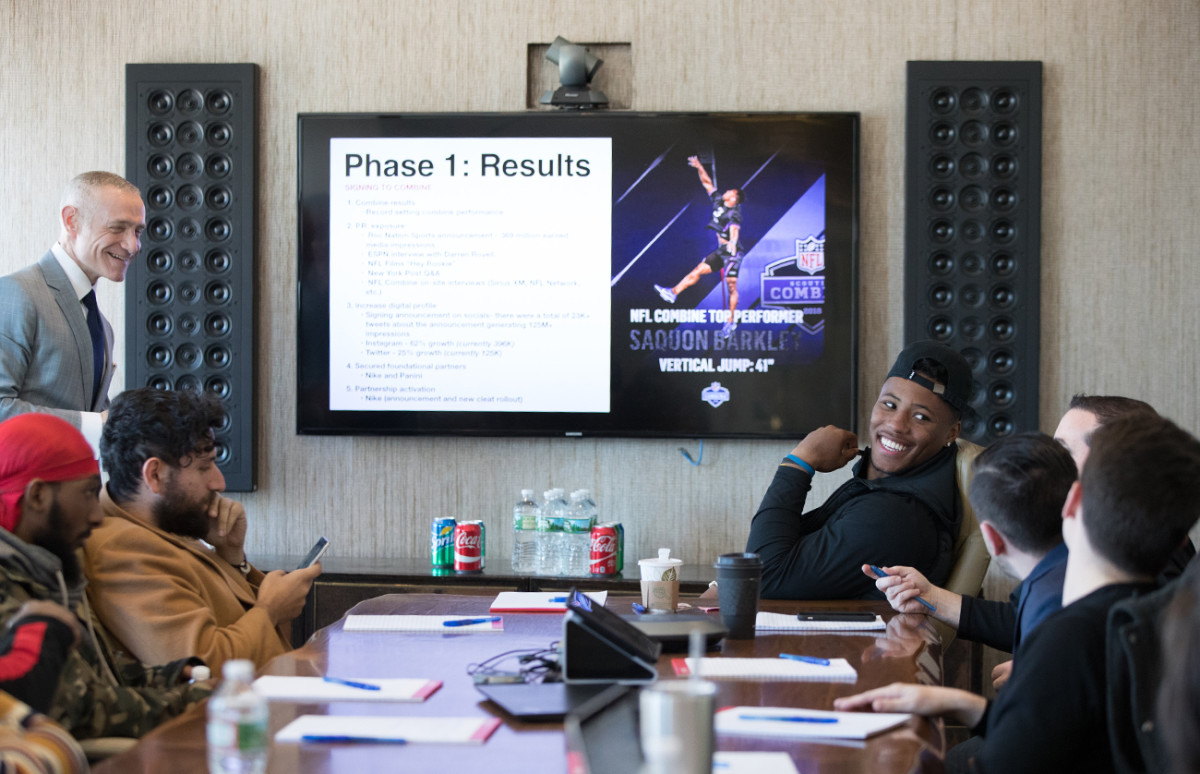
It will not be easy for a running back to achieve everything Barkley envisions. Nielsen’s N-Score assesses the endorsement potential of athletes, and “quarterbacks are by far the most well-known and highest-scoring among NFL players,” says Nielsen Sports senior vice president Lyndon Campbell. Running backs typically fall third on the positional hierarchy, behind receivers. Campbell notes three factors that play into N-score rankings—awareness (on a national level), on-field performance (both individual and team) and conduct (whether the player is seen as a “likable, wholesome, role model”). Now in the boardroom, the Saquon Barkley team discusses how it will bolster all three—making sure to carve out ample time for training, aware that all of these plans will be moot if his production doesn’t match his hype.
“The thing I want to do is build an image around myself,” Barkley says. “And do that safely and smartly.” There are murmurs and nods of approval.
David Carter, a sports business and strategic marketing expert who works for USC, sees Barkley’s meticulous avoidance of controversy as the reason he has a chance to become the next Face of the League. He has the requisite attributes—“refreshing, approachable, polished and consistent”—a player needs for the NFL to be comfortable with him across all mediums. With the NFL suffering from an image crisis, its biggest stars getting older (Brady, Rodgers), its younger stars being divisive (Odell, Zeke) or uninterested in marketing themselves (Gurley, Julio) the league needs someone fresh and anodyne to promote.

“The NFL is perceived to be this behemoth that is out of touch,” Carter says. “If you bring in a guy like Barkley who can bridge that, not only with all of his talent but who can also support the brand of the NFL, then you have one plus one equals three.”
Barkley is coming into a draft dominated by four passers—USC’s Sam Darnold, UCLA’s Josh Rosen, Wyoming’s Josh Allen and Oklahoma’s Baker Mayfield—who are divvying up all the media attention and marketing opportunities. Which one of these is not like the others? Carter asks. (In the boardroom, it’s gleefully noted that the news of Barkley’s signing with Roc Nation generated 369 million impressions online, while Rosen’s announcement that he’d joined Athletes First agency got only 30 million.) “If ever there was an opportunity for a running back [to become the Face of the League],” Carter says, “this would be it.”
Patriots Draft: The Case for Taking a QB, and the Case Against It
Barkley leans back in his leather chair, all eyes in the boardroom on him. He’s comfortable leading the discussion; he relishes having the power to shape his own future. He has been thinking about those Instagram accounts of women who have built huge followings just by posting butt exercise videos. He used to hate when athletes shared their workouts on social media. It felt so fake. But he’s also seen how James Harrison deployed that as a strategy to create a fervid fan base. Barkley wants in. “I feel we can do that to get to another level,” he says, before adding that it must be done in a way that is genuine—no staging extreme workouts just for the clicks.
Now Barkley wants to discuss brand partnerships. He has signed with Nike and Panini (which just released the Saquon Barkley rookie card), but what “secure financial partners . . . do we have next?” he asks. Most athletes simply want to be updated when a deal is finalized, asking how much money they got. But when Yormark was negotiating with Nike, Barkley guided the strategy and asked to be kept apprised throughout—while simultaneously balancing an offer from Adidas that would have netted him significantly more money. Barkley chose the long-term play, assured that Nike had plans for him to join its upper echelon of one-name stars. Kobe, LeBron, Jordan, Tiger, Serena . . . Saquon.
When Barkley was growing up, he just wanted to be a football player. But at Penn State he had frequent conversations with James Franklin—at the coach’s house for dinner, on the team plane following a game, before and after practice—about having a vision, a plan, about taking his future into his own hands. Franklin would tell Barkley that the NFL provides an amazing platform, then ask, How are you going to use that? How is that going to generate long-term wealth? Franklin told him about players who never touched their NFL paychecks and lived solely off endorsement deals. Barkley would take notes of their conversations. The NFL treats players like disposable commodities, Franklin cautioned—if your knee or shoulder gives out, you’ll be unceremoniously discarded. So he wanted Barkley to ensure that if that happens, he’d still be set for life. Now Barkley speaks twice a week with a financial adviser who is working on various equity deals and venture capital opportunities.
“For some guys that’s too big,” Franklin says. “But Saquon is doing these things at an age when most people aren’t. He’s been studying people that are successful for a long time.”
Adrian Peterson and Emmitt Smith couldn’t do it. Jim Brown and LaDainian Tomlinson fell short. Eric Dickerson, Earl Campbell, Marshall Faulk? No, no and no. The greatest running backs of all time couldn’t crack that top marketing spot. Most weren’t even the face of their franchises. Walter Payton, Barry Sanders and Bo Jackson came closest—behind only O.J. Simpson, who actually achieved Face of the League status in the 1970s. So history would tell you that Barkley’s best-laid plans amount to a long shot.
Barkley’s business team would argue that there has never been another back like him, a run-catch-and-return gamebreaker with impeccable character. It’s so neat and tidy that it’s enough to make one skeptical: Is it all just to burnish his image, just a facade? Those who know Barkley best say no, and they have stories to prove it. They can recall the random compliments he paid to teammates’ parents about their child’s football abilities when he was 11 years old. The countless hours he spent signing posters after games in State College, so no kid would go home empty-handed. The cleats he has pulled out of his gym bag at the airport to give to young fans who simply wanted a picture. Or the eight pairs he donated to another NFL prospect before the combine, after he learned he was working out in Timberlands.
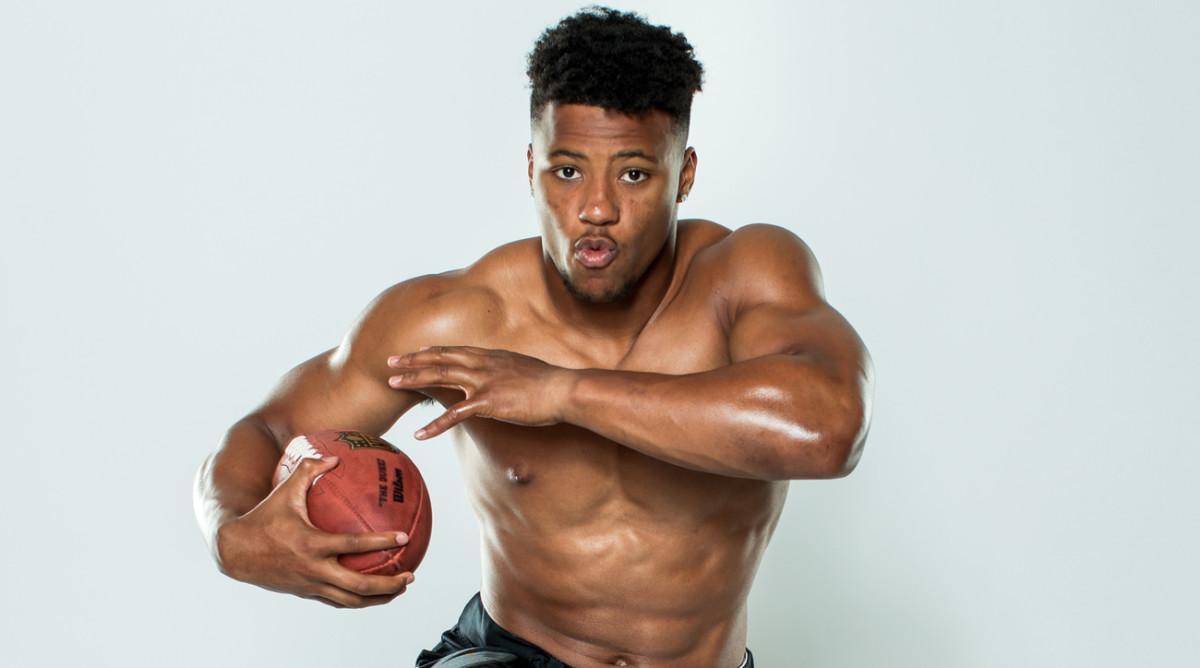
And then there’s the medal story. On the clay track behind Whitehall High during Barkley’s senior year, with Rachel Panek holding his starting block, Barkley earned his first gold medal after winning the 100-meter dash in the district championship. Minutes earlier Panek had won the girls’ 100-meter hurdles—but an electronic timing malfunction voided the results. They were forced to rerun the race, and this time Panek clipped a hurdle and finished eighth. Barkley watched this all unfold. Panek was from another school; they had never met before. But he slipped the medal off his neck and placed it around hers.
“This is before he was anybody,” Panek says. “That’s the kind of person he is.”
Franklin has been in football for 23 years and says he has never seen a player as talented or as altruistic as Barkley. One day Franklin offhandedly mentioned to a few of his players that his 11-year-old daughter, Shola, wasn’t being allowed to play football with the boys during recess. So Barkley visited the school and started his own game with Shola. Soon all the kids, girls and boys, joined in. When Barkley noticed one boy standing off to the side, he coaxed him onto the field. What kind of teenager—let alone an All-America running back—does that? Franklin wondered.
Shaquem Griffin’s Success Is About Design As Much as Desire
“That’s good for the NFL, that’s good for the game of football,” Franklin says. “That’s good for our country.”
Jeanne McNeill is the Pennsylvania state representative who sponsored the Saquon Barkley Day resolution. Why did she take the time to do so? Why Barkley? “Not because he is a famous sports star,” she says, but rather because he is an exemplary role model—honest, kind and respectful. “There is so much strife going on this world,” she says, “and Saquon gives people a reason to smile. We need more reasons to smile.”
Why should I not go No. 1?” Barkley asks. He genuinely wants an answer. With every other player in the draft class, he says, there’s a but. “With me, I can confidently say there is no but.” That’s why he thinks he’s different.
And Gil Brandt agrees. The legendary talent evaluator has worked in the NFL for 63 years, most notably as the vice president of player personnel for the Cowboys for three decades. He grades prospects on a nine-point system, broken down into five characteristics: character; quickness and agility; strength and explosion; competitiveness; and mental alertness. Over his career he has graded 492 running backs. Barkley ranks highest of them all.
“He has a 100% chance of being an All-Pro,” Brandt says. “He’s the best player in the draft.”
Barkley’s achievements for the Nittany Lions—the first player ever to be named Big Ten running back of the year, returner of the year and offensive player of the year in the same season; the 2017 Paul Hornung Award recipient for the nation’s most versatile performer; the second-most all-purpose yardage in the NCAA last season—were superseded only by his performance in the March NFL combine, which many have ranked among the most impressive ever. His 4.40 40-yard dash was the third best ever by a running back 230 pounds or heavier, his 41-inch vertical set the record for that same group, and his 29 bench press reps were the fifth most for any back 235 pounds or fewer. In other words, Barkley is both too fast and too strong for his size.
For two hours every night in the months leading up to the combine, Barkley took practice Wonderlic tests and studied tricks to speed up his pace. He sat at his kitchen table and sketched out different defensive coverages and receiving routes that he knew coaches would ask him to diagram during meetings. He printed out a book that had the names and photos of every general manager and head coach in the NFL, and each night Barkley flipped through the pages. So while quarterback Josh Allen would mistake Dan Marino for John Elway in Indianapolis, Barkley ensured that he would have no such lapse.
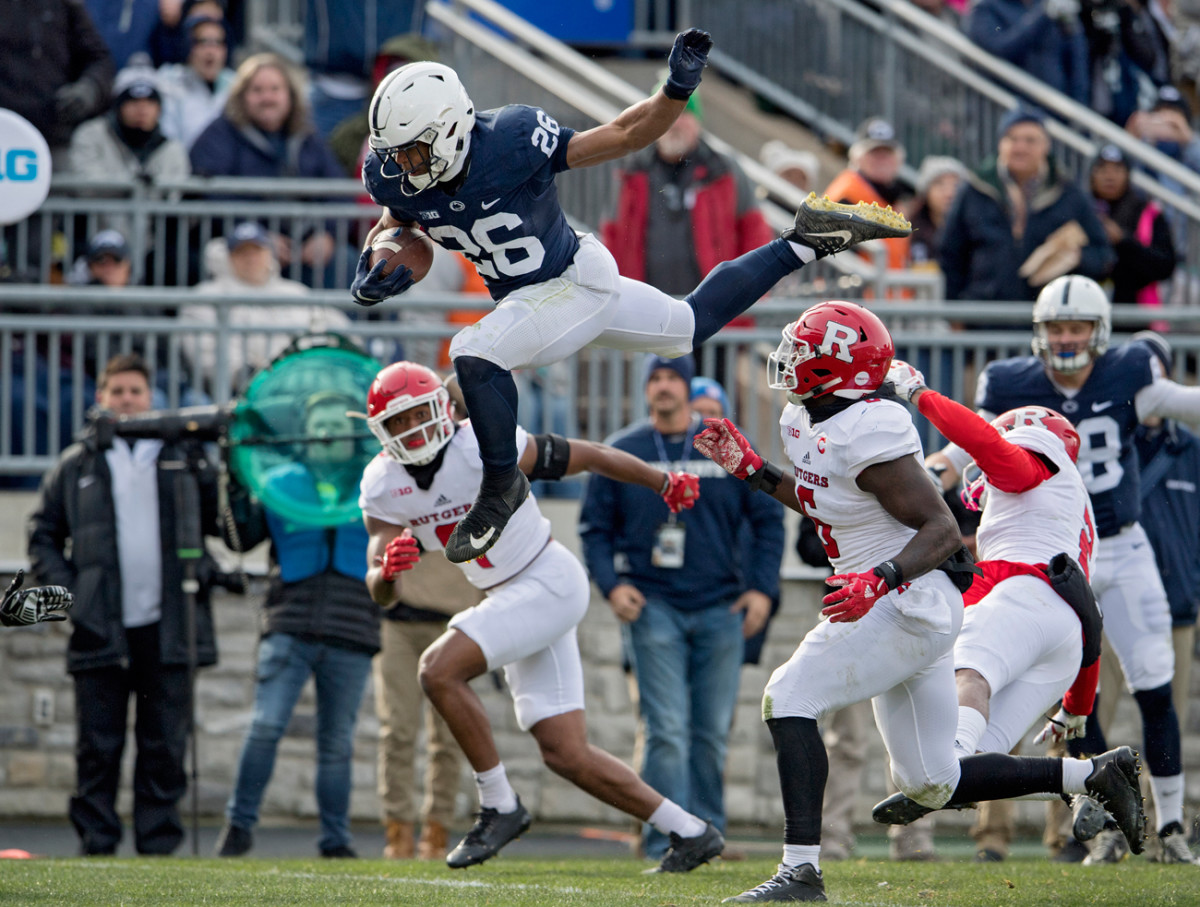
Still, Barkley has heard all the reasons why he isn’t worthy of the top pick. Unprompted, he enumerates each one, followed by his responses.
That QBs have the ball in their hands on every play and therefore affect the game in more ways than running backs. I do more than just run the football. That his career won’t last more than eight years. Psh. Less of something great is better than more of something good. That Penn State running backs don’t pan out. What does that have to do with me? That you can find a good running back later in the draft. You can find a good quarterback later in the draft too. That he didn’t show up in big games. What about the Rose Bowl against USC? Fiesta Bowl against Washington? Or the Ohio State game my freshman year, against the No. 1 team in the country?
Barkley averaged 175.0 yards rushing in those three games. “Who was best player on the field that day [against the Buckeyes]?” he says. “Me. Hands down. The arguments they make are so pointless.”
The NFL’s Wide Receiver Crisis
His Roc Nation handlers, however, don’t want him to be taken No. 1. They don’t want him in Cleveland. They want him to go second to the Giants and play in the media capital of the world. That’s where you can become the Face of the League. His manager even implored him to pull an Eli Manning and demand that the Browns not draft him. Barkley never considered the option. Sure, he likes the idea of being back in the city of his birth—even playing for the Jets, the team he grew up rooting for. And of course he’s heard countless people tell him that if he ends up in Cleveland, his career will be ruined.
Maybe they’re right. That could happen.
He’s happy to take that risk, though. For the last few weeks he has told close friends about a vision he has. He believes that if he brings a championship to the Land, as LeBron did, he’ll be hailed as the best athlete of his generation and have a statue built in his honor.
Now wouldn’t that be good for the brand?
Two hours after the Roc Nation meeting, Saquon Barkley and Curtis Martin are sitting at a long wooden table playing chess at Core, a members-only social club. With Sports Illustrated as a go-between, Martin invited Barkley to meet and compete in a friendly game. Now Barkley wants to soak up all the advice he can from his boyhood hero.
All day Barkley has been saying that Martin, the fifth leading rusher in NFL history, could likely embarrass him in the game—while also harboring the belief he could pull off the impossible. Martin, 44, has been playing chess for more than a decade; Barkley just picked it up a month ago after he found out that Martin played. Barkley is so obsessed with self-improvement and following in the footsteps of legends, so invested in carving a place in NFL annals, that he is now copying his heroes’ hobbies. But he still has much to learn, more to prove.
As they sit and talk, Saquon keeps turning to his father, Alibay, expressing his disbelief that he is sitting and talking with Curtis Martin. He says he’s trying to act cool and not seem like a little kid. When Saquon was two years old, he’d sit by his dad’s feet every Sunday as Alibay lounged on the couch, watching Martin play. “One day that will be me,” Saquon would say. Now Martin is telling Saquon that he has the chance to be better than he ever was.
“You get guys that have my type of potential every year,” Martin says. “But every once in a while you get a guy like you that comes into the league.”
Barkley tells Martin he believes he is not only capable of playing in the league, but also of dominating. He’s not Le’Veon Bell or Ezekiel Elliot or Alvin Kamara, he says, but he thinks he can do what each of those three backs can do. “And when you mash all that together, but better?” Barkley asks. “Then what does that make me?”
They begin the match. Barkley tells Martin to make the opening move, but the young back needs to be reminded by the old one that the white pieces move first. So Barkley flips the board around and Martin moves his king’s pawn two squares. He asks Barkley’s parents if there’s anything they have been concerned about. Alibay responds that there hasn’t been much, because his son is a good kid and they don’t worry about him doing anything stupid. But “you don’t really know what is going to happen until it happens,” he adds.
Martin says he often sits at the pool area outside Jim Brown’s house, and the two Hall of Famers will play for seven hours straight. Then Martin moves his king two squares toward one rook and that rook to the other side of his king. Barkley looks perplexed; he has never seen an opponent castle. Martin explains.
“What have I gotten myself into?” Barkley wonders aloud.
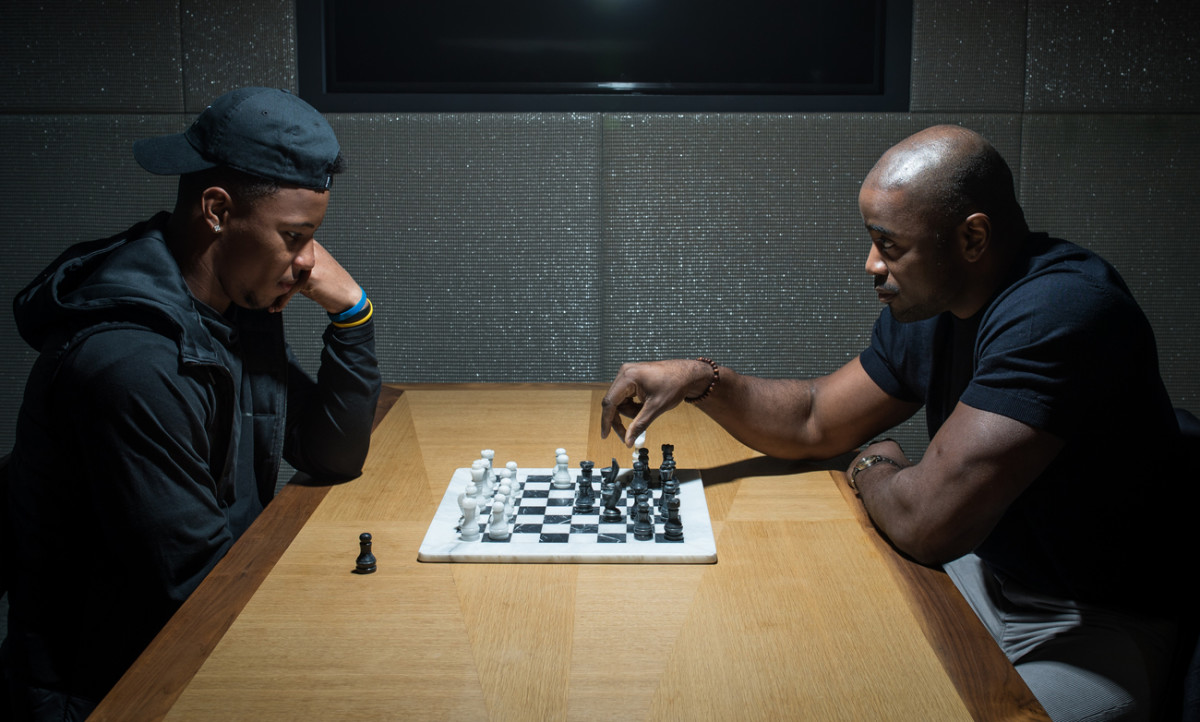
Martin continues doling out advice as he rapidly takes Barkley’s pieces. “Life is a lot like chess,” he says. He explains that he went into the NFL thinking about how he could take the opportunity and maximize it. He’s seen a lot of teammates and colleagues on other teams who had the opportunity, but they made mistakes off the field and squandered it. Martin tells Barkley he believes Saquon has the ability to break every record and become the best ever to play the game. But he also warns that Barkley is about to come into contact with three substantial influences: money, fame and power. Martin explains that if he ever had an enemy he wanted to conquer, he would give him all the money, the fame and the power that he could, then sit back and watch him self-destruct.
Just downstairs from where they’re sitting, Martin teaches a weekly life-study class. He gets rappers and movie stars and singers and athletes together in the theater room. Most of them have everything they could ever want in the world, but they’re the emptiest and most miserable people Martin has ever seen. “They weren’t always like that,” he says.
Martin takes Barkley’s bishop. Then a rook. He continues to talk. Most guys come into the league with a lot of hunger, he says. They have goals and dreams. They want to do good things, big things. But eventually the temptations and the partying begin to ruin them. Martin looks up at the perfect NFL prospect, the running back who could become the Face of the League. He doesn’t expect that Barkley will have that problem. But, Martin warns, if you’re not focused, all the plans, all the aspirations can vanish in a second.
He takes Barkley’s queen. Check.
“Your move,” Martin says.
Question or comment? Email us at talkback@themmqb.com.
